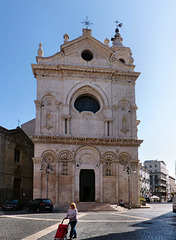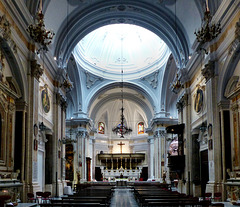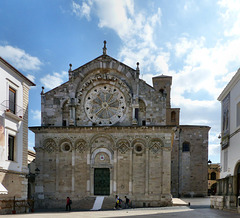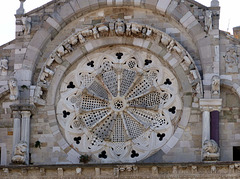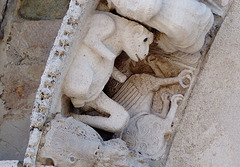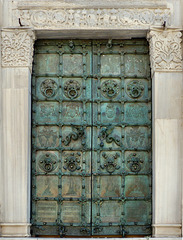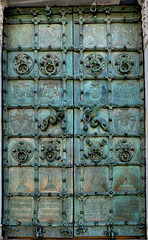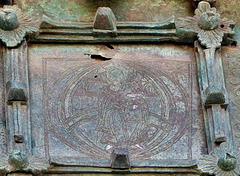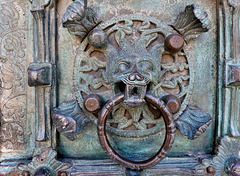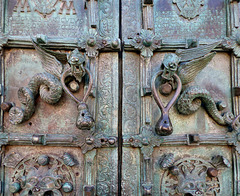
Puglia - Apulia - Apulien
Travelling slowly in Southern Italy.
Foggia - Cattedrale di Foggia
| |
|
|
Foggia was part of the Roman Empire and after the decline of Rome was under Lombard and around 1000 under Byzantine rule until taken by the Normans. As the area was marshy Robert Guiscard directed draining the wetland, what boosted the growth of the city. In the 12th century, William II of Sicily built a cathedral here and further enlarged the settlement. In 1223 Emperor Frederick II had a palace built here in which he often sojourned, together with his notable court, including persons such as the scholar Michael Scotus, who served as science adviser and court astrologer. Not much remains of this palace.
The Foggia Cathedral (aka "Cattedrale della Santa Maria Assunta in Coelo") was constructed as a collegiate church around 1170. A legend tells, that in 1062 a shepherd had found a miraculous image of the Virgin, wrapped in seven veils (= "Madonna dei Sette Veli") here.
The cathedral got modified a couple of times and nearly completely destroyed by an earthquake in 1731. It got restored in a Baroque style. Only the lower part of the facade survived the earthquake is still Romanesque.
Foggia - Cattedrale di Foggia
| |
|
Foggia was part of the Roman Empire and after the decline of Rome was under Lombard and around 1000 under Byzantine rule until taken by the Normans. As the area was marshy Robert Guiscard directed draining the wetland, what boosted the growth of the city. In the 12th century, William II of Sicily built a cathedral here and further enlarged the settlement. In 1223 Emperor Frederick II had a palace built here in which he often sojourned, together with his notable court, including persons such as the scholar Michael Scotus, who served as science adviser and court astrologer. Not much remains of this palace.
The Foggia Cathedral (aka "Cattedrale della Santa Maria Assunta in Coelo") was constructed as a collegiate church around 1170. A legend tells, that in 1062 a shepherd had found a miraculous image of the Virgin, wrapped in seven veils (= "Madonna dei Sette Veli") here.
The cathedral got modified a couple of times and nearly completely destroyed by an earthquake in 1731. It got restored in a Baroque style. Only the lower part of the facade survived the earthquake, so this and some rather weathered and damaged works are along the outside walls are still Romanesque.
Foggia - Cattedrale di Foggia
| |
|
|
Foggia was part of the Roman Empire and after the decline of Rome was under Lombard and around 1000 under Byzantine rule until taken by the Normans. As the area was marshy Robert Guiscard directed draining the wetland, what boosted the growth of the city. In the 12th century, William II of Sicily built a cathedral here and further enlarged the settlement. In 1223 Emperor Frederick II had a palace built here in which he often sojourned, together with his notable court, including persons such as the scholar Michael Scotus, who served as science adviser and court astrologer. Not much remains of this palace.
The Foggia Cathedral (aka "Cattedrale della Santa Maria Assunta in Coelo") was constructed as a collegiate church around 1170. A legend tells, that in 1062 a shepherd had found a miraculous image of the Virgin, wrapped in seven veils (= "Madonna dei Sette Veli") here.
The cathedral got modified a couple of times and nearly completely destroyed by an earthquake in 1731. It got restored in a Baroque style.
Troia - Concattedrale di Troia
| |
|
|
Troia was probably founded by Greek settlers under the name of Aecae. The current Troia was founded as a fortified town in 1018 the by the Byzantine general Basil Boiannes. For long it was a stronghold against the Normans and got besieged by the emperors Henry II and Frederick II, who destroyed the town in 1229.
He did not touch the "Concattedrale della Beata Vergine Maria Assunta in Cielo", erected in the first quarter of the 12th century where a Byzantine church formerly stood, that was apparently constructed largely from the remains of Roman buildings.
The Concattedrale di Troia is reckoned a masterpiece of Apulian Romanesque architecture and is particularly noted for the rose window and the bronze doors of the west front. Once it was the seat of the Bishops of Troia, it is now a co-cathedral in the diocese of Lucera-Troia.
Troia - Concattedrale di Troia
| |
|
|
|
Troia was probably founded by Greek settlers under the name of Aecae. The current Troia was founded as a fortified town in 1018 the by the Byzantine general Basil Boiannes. For long it was a stronghold against the Normans and got besieged by the emperors Henry II and Frederick II, who destroyed the town in 1229.
He did not touch the "Concattedrale della Beata Vergine Maria Assunta in Cielo", erected in the first quarter of the 12th century where a Byzantine church formerly stood, that was apparently constructed largely from the remains of Roman buildings.
The Concattedrale di Troia is reckoned a masterpiece of Apulian Romanesque architecture and is particularly noted for the rose window and the bronze doors of the west front. Once it was the seat of the Bishops of Troia, it is now a co-cathedral in the diocese of Lucera-Troia.
The central rose window is very complex. The upper half is framed by a semicircle populated by strange and mythical animals.
Troia - Concattedrale di Troia
| |
|
|
Troia was probably founded by Greek settlers under the name of Aecae. The current Troia was founded as a fortified town in 1018 the by the Byzantine general Basil Boiannes. For long it was a stronghold against the Normans and got besieged by the emperors Henry II and Frederick II, who destroyed the town in 1229.
He did not touch the "Concattedrale della Beata Vergine Maria Assunta in Cielo", erected in the first quarter of the 12th century where a Byzantine church formerly stood, that was apparently constructed largely from the remains of Roman buildings.
The Concattedrale di Troia is reckoned a masterpiece of Apulian Romanesque architecture and is particularly noted for the rose window and the bronze doors of the west front. Once it was the seat of the Bishops of Troia, it is now a co-cathedral in the diocese of Lucera-Troia.
The central rose window is very complex. The upper half is framed by a semicircle populated by strange and mythical animals. Here is a monkey and behind a griffon.
Troia - Concattedrale di Troia
| |
|
|
Troia was probably founded by Greek settlers under the name of Aecae. The current Troia was founded as a fortified town in 1018 the by the Byzantine general Basil Boiannes. For long it was a stronghold against the Normans and got besieged by the emperors Henry II and Frederick II, who destroyed the town in 1229.
He did not touch the "Concattedrale della Beata Vergine Maria Assunta in Cielo", erected in the first quarter of the 12th century where a Byzantine church formerly stood, that was apparently constructed largely from the remains of Roman buildings.
The Concattedrale di Troia is reckoned a masterpiece of Apulian Romanesque architecture and is particularly noted for the rose window and the bronze doors of the west front. Once it was the seat of the Bishops of Troia, it is now a co-cathedral in the diocese of Lucera-Troia.
The central rose window of the facade is very complex. The upper half is framed by a semicircle populated by strange and mythical animals. Some sculptures, integrated into the Concattedrale´s facade seem to be older, spoliae somehow "glued" in here.
Troia - Concattedrale di Troia
| |
|
|
Troia was probably founded by Greek settlers under the name of Aecae. The current Troia was founded as a fortified town in 1018 the by the Byzantine general Basil Boiannes. For long it was a stronghold against the Normans and got besieged by the emperors Henry II and Frederick II, who destroyed the town in 1229.
He did not touch the "Concattedrale della Beata Vergine Maria Assunta in Cielo", erected in the first quarter of the 12th century where a Byzantine church formerly stood, that was apparently constructed largely from the remains of Roman buildings.
The Concattedrale di Troia is reckoned a masterpiece of Apulian Romanesque architecture and is particularly noted for the rose window and the bronze doors of the west front. Once it was the seat of the Bishops of Troia, it is now a co-cathedral in the diocese of Lucera-Troia.
The central rose window of the facade is very complex. The upper half is framed by a semicircle populated by strange and mythical animals. Some sculptures, integrated into the Concattedrale´s facade seem to be older, somehow "glued" in here. Here may be three spoliae. On the left is a stone with an inscription (Roman?), the head of the (nude!) spinario (?) does not really fit the body.
Troia - Concattedrale di Troia
| |
|
|
Troia was probably founded by Greek settlers under the name of Aecae. The current Troia was founded as a fortified town in 1018 the by the Byzantine general Basil Boiannes. For long it was a stronghold against the Normans and got besieged by the emperors Henry II and Frederick II, who destroyed the town in 1229.
He did not touch the "Concattedrale della Beata Vergine Maria Assunta in Cielo", erected in the first quarter of the 12th century where a Byzantine church formerly stood, that was apparently constructed largely from the remains of Roman buildings.
The Concattedrale di Troia is reckoned a masterpiece of Apulian Romanesque architecture and is particularly noted for the rose window and the bronze doors of the west front. Once it was the seat of the Bishops of Troia, it is now a co-cathedral in the diocese of Lucera-Troia.
The central rose window of the facade is very complex. The upper half is framed by a semicircle populated by strange, mythical animals, atlants - and this medieval love couple.
Troia - Concattedrale di Troia
| |
|
|
|
Troia was probably founded by Greek settlers under the name of Aecae. The current Troia was founded as a fortified town in 1018 the by the Byzantine general Basil Boiannes. For long it was a stronghold against the Normans and got besieged by the emperors' Henry II and Frederick II, who destroyed the town in 1229.
He did not touch the "Concattedrale della Beata Vergine Maria Assunta in Cielo", erected in the first quarter of the 12th century where a Byzantine church formerly stood, that was apparently constructed largely from the remains of Roman buildings.
The Concattedrale di Troia, once the seat of the Bishops of Troia, now a co-cathedral in the diocese of Lucera-Troia, is reckoned a masterpiece of Apulian Romanesque architecture.
In particular, it is noted for the bronze doors of the main portal, created by Oderisio da Benevento in niello technique. For Ursula Mende ("Die Bronzetüren des Mittelalters") these are medieval masterpieces.
Some parts were added during a restoration in 1573. The inscription on the four panels below reads
An[n]o ab incarnatio[n]e/d[omi]ni n[o]stri Ie[s]v Xr[ist]i mil[e]simo/centisimo nondecimo/indictione dvodecima
Anno pontificat[us] d[omi]ni/Kalisti P[a]p[e] secvndi p[rimo]/ann[o] dvcat[us] W[ilelmi] Rocerii/clo[rio]si dvcis filii nono
Willelmvs secvnd[us]/hui[us] Troiane sedis ep[i]s[copus]/erat svi an[no] XII has/portas fieri fecit
DE PROPRIO ECCLESIAE AERARIO IPSAMQUE FABRICAM A FUNDAMENTIS FERE EXIT
what translates to
In the 1119th year from the incarnation of Our Lord Jesus Christ and in the twelfth indiction /
In the first year of the pontificate of the Lord Pope Callixtus II / and the ninth year of the rule of Duke William son of Roger the Glorious /
William the Second, who was bishop of the See of Troia, in his twelfth year caused these doors to be made /
From his own wealth for the church and the fabric of the same to be raised almost from the foundations.
Troia - Concattedrale di Troia
| |
|
Troia was probably founded by Greek settlers under the name of Aecae. The current Troia was founded as a fortified town in 1018 the by the Byzantine general Basil Boiannes. For long it was a stronghold against the Normans and got besieged by the emperors Henry II and Frederick II, who destroyed the town in 1229.
He did not touch the "Concattedrale della Beata Vergine Maria Assunta in Cielo", erected in the first quarter of the 12th century where a Byzantine church formerly stood, that was apparently constructed largely from the remains of Roman buildings.
The Concattedrale di Troia, once the seat of the Bishops of Troia, now a co-cathedral in the diocese of Lucera-Troia, is reckoned a masterpiece of Apulian Romanesque architecture.
In particularly it is noted for the bronze doors of the main portal, created by Oderisio da Benevento in niello technique. For Ursula Mende ("Die Bronzetüren des Mittelalters") these are medieval masterpieces.
Some parts were added during a restauration in 1573. The inscription on the four panels below reads
An[n]o ab incarnatio[n]e/d[omi]ni n[o]stri Ie[s]v Xr[ist]i mil[e]simo/centisimo nondecimo/indictione dvodecima
Anno pontificat[us] d[omi]ni/Kalisti P[a]p[e] secvndi p[rimo]/ann[o] dvcat[us] W[ilelmi] Rocerii/clo[rio]si dvcis filii nono
Willelmvs secvnd[us]/hui[us] Troiane sedis ep[i]s[copus]/erat svi an[no] XII has/portas fieri fecit
DE PROPRIO ECCLESIAE AERARIO IPSAMQUE FABRICAM A FUNDAMENTIS FERE EXIT
what translates to
In the 1119th year from the incarnation of Our Lord Jesus Christ and in the twelfth indiction /
In the first year of the pontificate of the Lord Pope Callixtus II / and the ninth year of the rule of Duke William son of Roger the Glorious /
William the Second, who was bishop of the See of Troia, in his twelfth year caused these doors to be made /
From his own wealth for the church and the fabric of the same to be raised almost from the foundations.
Troia - Concattedrale di Troia
| |
|
Troia was probably founded by Greek settlers under the name of Aecae. The current Troia was founded as a fortified town in 1018 the by the Byzantine general Basil Boiannes. For long it was a stronghold against the Normans and got besieged by the emperors Henry II and Frederick II, who destroyed the town in 1229.
He did not touch the "Concattedrale della Beata Vergine Maria Assunta in Cielo", erected in the first quarter of the 12th century where a Byzantine church formerly stood, that was apparently constructed largely from the remains of Roman buildings.
The Concattedrale di Troia, once the seat of the Bishops of Troia, now a co-cathedral in the diocese of Lucera-Troia, is reckoned a masterpiece of Apulian Romanesque architecture.
In particular, it is noted for the bronze doors of the main portal, created in 1119 by Oderisio da Benevento in niello technique. For Ursula Mende ("Die Bronzetüren des Mittelalters") these are medieval masterpieces. The artist knew about the quality of his work, as he "signed" it. This is the left panel of the top row. There are two persons.
The left one is ODERISIUS, the right one is BERADRUS.
An early selfie.
Troia - Concattedrale di Troia
| |
|
Troia was probably founded by Greek settlers under the name of Aecae. The current Troia was founded as a fortified town in 1018 the by the Byzantine general Basil Boiannes. For long it was a stronghold against the Normans and got besieged by the emperors Henry II and Frederick II, who destroyed the town in 1229.
He did not touch the "Concattedrale della Beata Vergine Maria Assunta in Cielo", erected in the first quarter of the 12th century where a Byzantine church formerly stood, that was apparently constructed largely from the remains of Roman buildings.
The Concattedrale di Troia, once the seat of the Bishops of Troia, now a co-cathedral in the diocese of Lucera-Troia, is reckoned a masterpiece of Apulian Romanesque architecture.
In particularly it is noted for the bronze doors of the main portal, created in 1119 by Oderisio da Benevento in niello technique, who "signed" his work. For Ursula Mende ("Die Bronzetüren des Mittelalters") these are medieval masterpieces.
This is the second left panel of the top row.
Christus Pantokrator
Troia - Concattedrale di Troia
| |
|
Troia was probably founded by Greek settlers under the name of Aecae. The current Troia was founded as a fortified town in 1018 the by the Byzantine general Basil Boiannes. For long it was a stronghold against the Normans and got besieged by the emperors Henry II and Frederick II, who destroyed the town in 1229.
He did not touch the "Concattedrale della Beata Vergine Maria Assunta in Cielo", erected in the first quarter of the 12th century where a Byzantine church formerly stood, that was apparently constructed largely from the remains of Roman buildings.
The Concattedrale di Troia, once the seat of the Bishops of Troia, now a co-cathedral in the diocese of Lucera-Troia, is reckoned a masterpiece of Apulian Romanesque architecture.
In particularly it is noted for the bronze doors of the main portal, created in 1119 by Oderisio da Benevento in niello technique, who "signed" his work. For Ursula Mende ("Die Bronzetüren des Mittelalters") these are medieval masterpieces.
This is the very right panel of the top row.
Petrus and Paulus
Troia - Concattedrale di Troia
| |
|
|
Troia was probably founded by Greek settlers under the name of Aecae. The current Troia was founded as a fortified town in 1018 the by the Byzantine general Basil Boiannes. For long it was a stronghold against the Normans and got besieged by the emperors Henry II and Frederick II, who destroyed the town in 1229.
He did not touch the "Concattedrale della Beata Vergine Maria Assunta in Cielo", erected in the first quarter of the 12th century where a Byzantine church formerly stood, that was apparently constructed largely from the remains of Roman buildings.
The Concattedrale di Troia, once the seat of the Bishops of Troia, now a co-cathedral in the diocese of Lucera-Troia, is reckoned a masterpiece of Apulian Romanesque architecture.
In particularly it is noted for the bronze doors of the main portal, created in 1119 by Oderisio da Benevento in niello technique, who "signed" his work. For Ursula Mende ("Die Bronzetüren des Mittelalters") these are medieval masterpieces.
This is one of eight (!) lions.
Troia - Concattedrale di Troia
| |
|
|
|
Troia was probably founded by Greek settlers under the name of Aecae. The current Troia was founded as a fortified town in 1018 the by the Byzantine general Basil Boiannes. For long it was a stronghold against the Normans and got besieged by the emperors Henry II and Frederick II, who destroyed the town in 1229.
He did not touch the "Concattedrale della Beata Vergine Maria Assunta in Cielo", erected in the first quarter of the 12th century where a Byzantine church formerly stood, that was apparently constructed largely from the remains of Roman buildings.
The Concattedrale di Troia, once the seat of the Bishops of Troia, now a co-cathedral in the diocese of Lucera-Troia, is reckoned a masterpiece of Apulian Romanesque architecture.
In particularly it is noted for the bronze doors of the main portal, created in 1119 by Oderisio da Benevento in niello technique, who "signed" his work. For Ursula Mende ("Die Bronzetüren des Mittelalters") these are medieval masterpieces.
In the center are these two doorknockers.
Troia - Concattedrale di Troia
| |
|
|
Troia was probably founded by Greek settlers under the name of Aecae. The current Troia was founded as a fortified town in 1018 the by the Byzantine general Basil Boiannes. For long it was a stronghold against the Normans and got besieged by the emperors Henry II and Frederick II, who destroyed the town in 1229.
He did not touch the "Concattedrale della Beata Vergine Maria Assunta in Cielo", erected in the first quarter of the 12th century where a Byzantine church formerly stood, that was apparently constructed largely from the remains of Roman buildings.
The Concattedrale di Troia, once the seat of the Bishops of Troia, now a co-cathedral in the diocese of Lucera-Troia, is reckoned a masterpiece of Apulian Romanesque architecture.
In particularly it is noted for the bronze doors of the main portal, created in 1119 by Oderisio da Benevento in niello technique, who "signed" his work. For Ursula Mende ("Die Bronzetüren des Mittelalters") these are medieval masterpieces.
The Concattedrale di Troia has a side portal, that like the main portal was created by Oderisio da Benevento.
Troia - Concattedrale di Troia
| |
|
Troia was probably founded by Greek settlers under the name of Aecae. The current Troia was founded as a fortified town in 1018 the by the Byzantine general Basil Boiannes. For long it was a stronghold against the Normans and got besieged by the emperors Henry II and Frederick II, who destroyed the town in 1229.
He did not touch the "Concattedrale della Beata Vergine Maria Assunta in Cielo", erected in the first quarter of the 12th century where a Byzantine church formerly stood, that was apparently constructed largely from the remains of Roman buildings.
The Concattedrale di Troia, once the seat of the Bishops of Troia, now a co-cathedral in the diocese of Lucera-Troia, is reckoned a masterpiece of Apulian Romanesque architecture.
In particularly it is noted for the bronze doors of the main portal, created in 1119 by Oderisio da Benevento in niello technique, who "signed" his work. For Ursula Mende ("Die Bronzetüren des Mittelalters") these are medieval masterpieces.
The Concattedrale di Troia has a side portal, that like the main portal was created by Oderisio da Benevento. Here is an overview.
Jump to top
RSS feed- Latest items - Subscribe to the latest items added to this album
- ipernity © 2007-2024
- Help & Contact
|
Club news
|
About ipernity
|
History |
ipernity Club & Prices |
Guide of good conduct
Donate | Group guidelines | Privacy policy | Terms of use | Statutes | In memoria -
Facebook
Twitter

